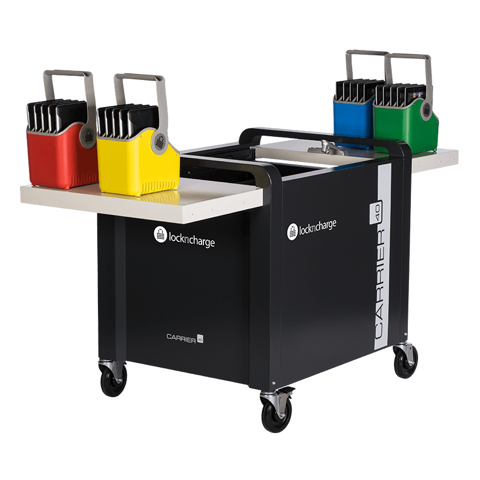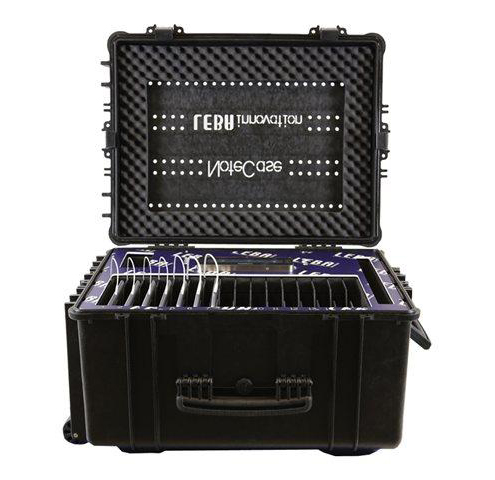
iOS Charging Solutions
Many schools and educational institutions are now investing in classroom sets of iPads and are hoping to transform the learning experience of their pupils. However, has anyone thought about the practicalities of supporting these devices, and particularly, how you're going to ensure they're fully charged and ready to use throughout the school, every single day?
This blog is intended to explore some of the options available as well as answer some of the questions that we are regularly asked, so that you can make a more informed decision on which iPad charging solution will be best for you.
There are three basic types of iPad charging solution; the charging trolley, the flight-case and the cabinet. Whilst all do broadly the same task, how and where you would use and place them in a school environment would be very different as they help to address different needs.
The charging trolley

This is the most common solution and is found in a majority of schools and educational establishments with classroom sets of iPads deployed. With its four-wheeled-design, the charge trolley is easily moved from classroom to classroom and the many variants can carry 16, up to as many as 40 iPads at a time, enough for classrooms or groups of all sizes.
The flight-case

This is an ideal solution for schools who have a need for their iPads to be mobile and want to ensure that devices are secure and safe in transit. Whereas an iPad trolley can hold up to 40 devices, the flight-cases are smaller and hold up to 16 at a time in a ruggedized, wheeled trolley that can be easily loaded and shipped for events and field-trips.
The Cabinet

This last device is the smallest of the three and is generally a free-standing or wall-mounted product for environments with only a few devices to charge. Typically cabinets hold up to 10 devices at any one time. They are often found deployed in areas such as staff rooms or school resource areas.
Physical Considerations
Clearly, no two schools are the same and every institutions needs are specific to their own environments and requirements. To avoid potentially purchasing a charging solution that is either inadequate or excessive for your needs, here are some questions and considerations to bear in mind before committing to a purchase -.
• Where do you propose storing your devices overnight?
• Have you a secure cupboard or storeroom big enough to wheel a trolley in to?
• Does that room have a mains power source to plug the trolley into?
• Can a fixed-anchor hard-point be installed into a solid wall or floor?
• Are all the doors between the settings where the iPads will need to travel between, wide enough to accommodate a trolley or flight case on wheels?
If your school is spread over multiple floors, and your iPads are used across many classrooms, the larger capacity trollies may not be ideal due to their size and weight. Multiple, smaller trollies will be a better solution for anyone in that kind of environment. Similarly, you may find multiple small trollies avoid the issue of moving a large, heavy trolly around a school spread across multiple buildings.
Security
With the possibility of having 40 iPads located conveniently together, it's sadly a natural target for theft, (one fully loaded iPad trolley could have a value in excess of £20,000). Keeping the trolley and it's cargo of iPads secure should be a major consideration. When evaluating the various options, ensure your chosen solution has several features to stop theft, not just of the whole unit but of the contents too. The Lock & Charge series of trollies, for example, has not only a pair of solid D-rings on its base to allow tethering to an anchor point, but also a key-operated top tray to help prevent casual theft of devices from within the trolley, features not often seen on cheaper, budget options.
Portable flight-cases obviously provide a different problem. Whilst they are ruggedized for protection whilst in transit, they generally have little in the way of theft prevention. Purchasing padlocks, tethers and other security devices is advisable if such items are to be used in a open, or vulnerable area and particularly for when, and where, they are likely to be stored.
Lastly, iPad cabinets. Whilst these are arguably the most secure of devices when attached to a wall, the devices themselves are usually of a lightweight construction and the locking mechanisms can be relatively easy to get through. Consider the environment they are likely to be deployed into and whether the items within could be at risk. iPads are very popular devices for staff-room use when there is a regular need for short bursts of charging, or similarly, when used in supervised, self-service areas such as a library, where there is a minimal risk of theft during the day due to them being high-traffic areas.
FAQ's
We've summarized some of the most frequent and useful questions we are asked about our various iPad charging solutions and how they fit in with the principles and considerations outlined above.
Question : Can I store different iOS devices within the same charging device?
Answer: Generally yes. All types have plenty of free space to host items as small as an iPhone up to the iPad with 9.7" screen, however the larger 12.9" iPad Pro won't fit many portable desktop/cabinet products, so its worth a discussion to check on suitability for individual devices.
Question: My iPads are placed in rugged protective cases. Will they still fit?
Answer: Even with the bulkier, more protective styles of case, most charging solutions for schools are designed to accommodate the device and it's protective case.
Question: How heavy are the charging trollies? Is it practical to lift them up and down the stairs in school?
Answer: Some of the trollies such as the Lock n Charge Carrier 40 can weigh in excess of 70kg, and will be over 80kg when populated, so it's generally not recommended to lift them up and down stairs in a busy school environment by hand.
Question: If I purchase a single tabletop charging cabinet and my needs expand, can I add them together?
Answer: In the case of the Griffin Multidock specifically, then yes you can. These can be stacked three-high and even be converted into a wheeled unit for added portability.
To finish, whilst no two iPad deployments are ever the same, some of the questions, queries and concerns around charging solutions are, but if you've anything specific that hasn't been covered by the above then please feel free to call us and ask us anything about the solutions we can offer.
Contact us
0115 985 1797
Follow us on Twitter @krcs_education
No Comments yet. be the first to comment.